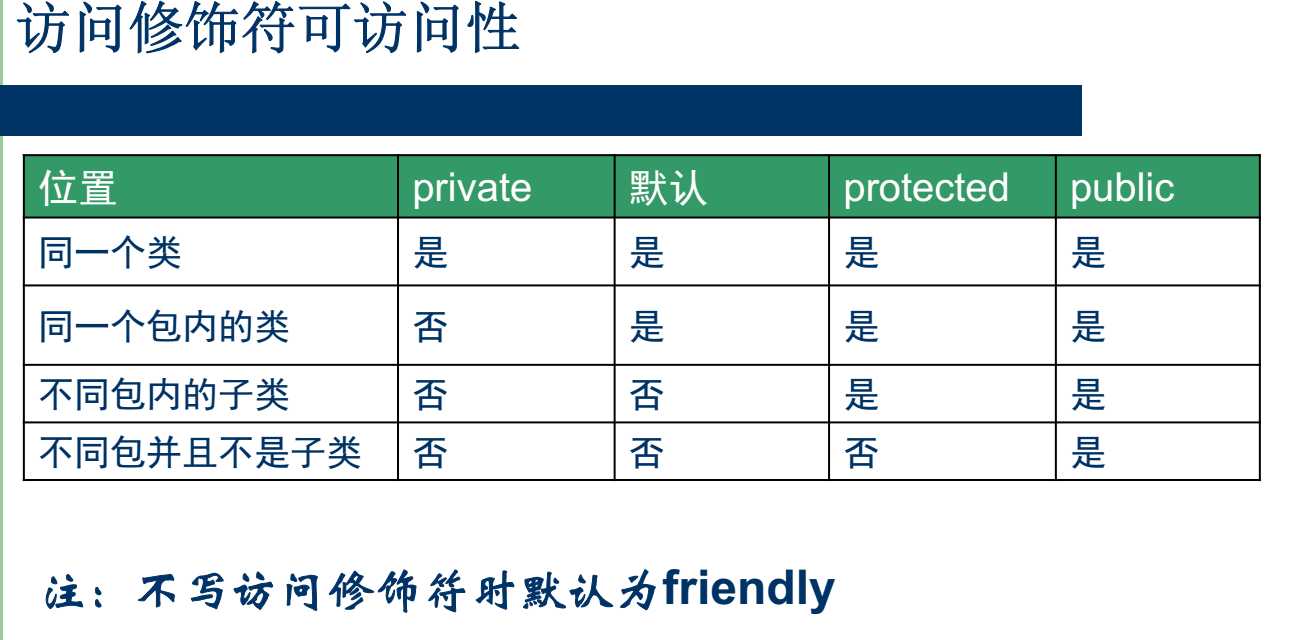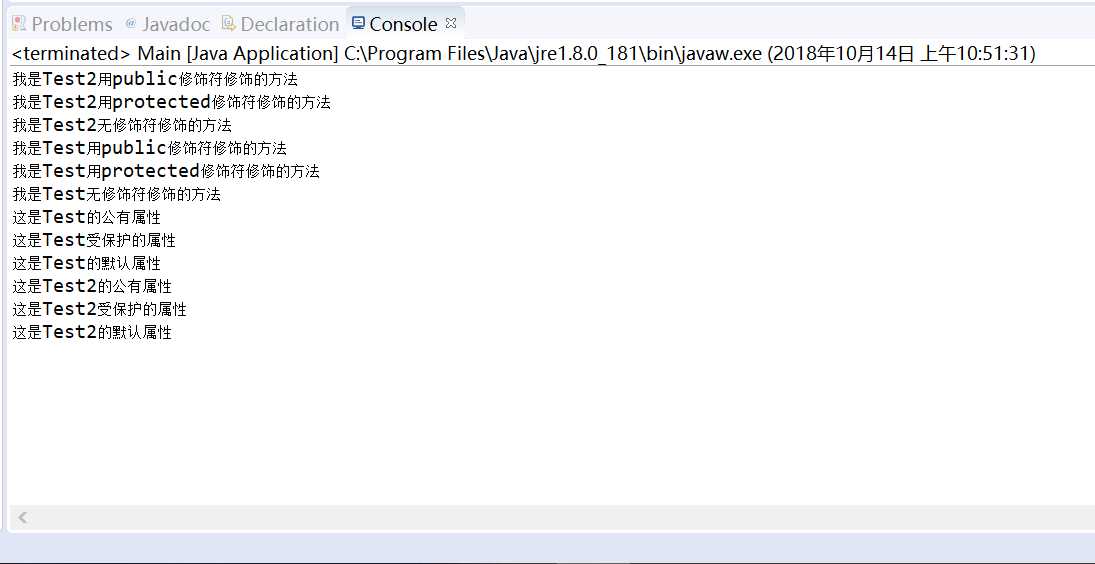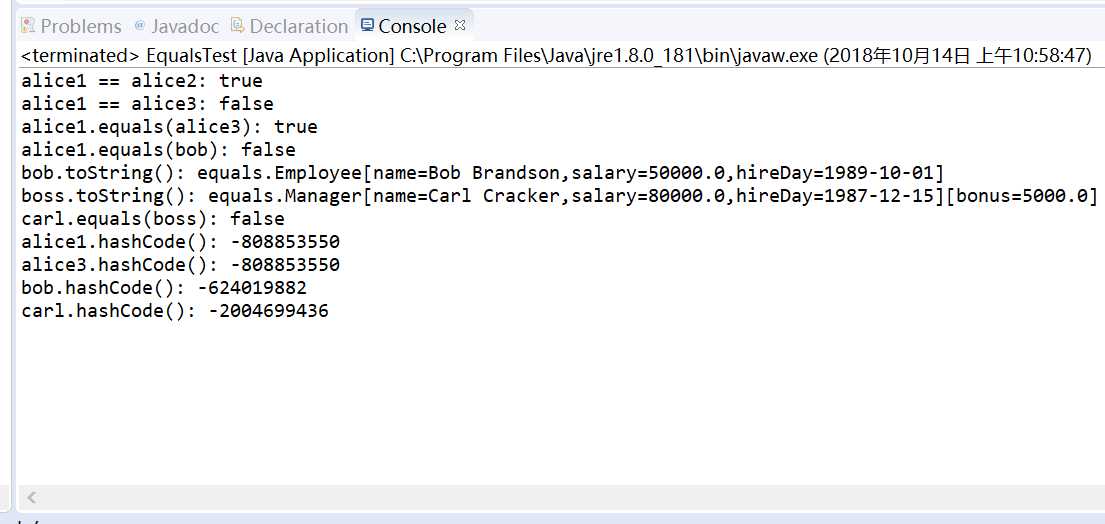标签:put explicit eth 创建 objects 类型信息 特点 语法 mon
第七周学习总结
第一部分:理论知识
1.继承是面向对象程序设计(Object Oriented Programming-OOP)中软件重用的关键技术。继承机制使用已经定义的类作为基础建立新的类定义,新的类是原有类的数据及操作与新类所增加的数据及操作组合。新的类把原有的类作为基类引用,而不需要修改原有类的定义。新定义的类作为派生类引用。这种方式减少代码数量,让代码简洁,易懂。
? 继承可以传递,但是继承时单项的。
? 多继承的容易出现二义性,慎用。
? 私有成员不被继承,不能被派生类使用。
2.访问修饰符可访问性:

3.0bject:
0bject类是Java中所有类的祖先一每- 一个类都由它扩展而来。在不给出超类的情况下,Java会自动把0bject作为要定义类的超类。
可以使用类型为0b ject的变量指向任意类型的对象。但要对它们进行专门的操作都要进行类型转换。
第二部分:实验部分:
1、实验目的与要求
(1)进一步理解4个成员访问权限修饰符的用途;
(2)掌握Object类的常用API用法;
(3)掌握ArrayList类用法与常用API;
(4)掌握枚举类使用方法;
(5)结合本章知识,理解继承与多态性两个面向对象程序设计特征,并体会其优点;
(6)熟练掌握Java语言中基于类、继承技术构造程序的语法知识(ch1-ch5);
(7)利用已掌握Java语言程序设计知识,学习设计开发含有1个主类、2个以上用户自定义类的应用程序。
2、实验内容和步骤
实验1 补充以下程序中主类内main方法体,以验证四种权限修饰符的用法。
1 public class Test { 2 private String t1 = "这是 Test 的私有属性"; 3 public String t2 = "这是Test的公有属性"; 4 protected String t3 = "这是Test受保护的属性"; 5 String t4 = "这是Test的默认属性"; 6 private void tese1() { 7 System.out.println("我是Test用private修饰符修饰的方法"); 8 } 9 public void tese2() { 10 System.out.println("我是Test用public修饰符修饰的方法"); 11 } 12 protected void tese3() { 13 System.out.println("我是Test用protected修饰符修饰的方法"); 14 } 15 void tese4() { 16 System.out.println("我是Test无修饰符修饰的方法"); 17 } 18 } 19 public class Test2 extends Test{ 20 private String e1 = "这是Test2的私有属性"; 21 public String e2 = "这是Test2的公有属性"; 22 protected String e3 = "这是Test2受保护的属性"; 23 String e4 = "这是Test2的默认属性"; 24 public void demo1() { 25 System.out.println("我是Test2用public修饰符修饰的方法"); 26 } 27 private void demo2() { 28 System.out.println("我是Test2用private修饰符修饰的方法"); 29 } 30 protected void demo3() { 31 System.out.println("我是Test2用protected修饰符修饰的方法"); 32 } 33 void demo4() { 34 System.out.println("我是Test2无修饰符修饰的方法"); 35 } 36 } 37 public class Main { 38 public static void main(String[] args) { 39 Test2 test= new Test2(); 40 /*以下设计代码分别调用 demo1 demo2 demo3 demo4 test1 test2 test3 test4方法和t1 t2 t3 t3 e1 e2 e3 e4属性,结合程序运行结果理解继承和权限修饰符的用法与区别*/ 41 42 test.demo1(); 43 test.demo3(); 44 test.demo4(); 45 46 test.tese2(); 47 test.tese3(); 48 test.tese4(); 49 50 System.out.println(test.t2); 51 System.out.println(test.t3); 52 System.out.println(test.t4); 53 System.out.println(test.e2); 54 System.out.println(test.e3); 55 System.out.println(test.e4); 56 } 57 }

实验2 第五章测试程序反思,继承知识总结。
测试程序1:
? 编辑、编译、调试运行教材程序5-8、5-9、5-10(教材174页-177页);
? 结合程序运行结果,理解程序代码,掌握Object类的定义及用法;
1 package equals; 2 3 import java.time.*; 4 import java.util.Objects; 5 6 public class Employee 7 { 8 private String name; 9 private double salary; 10 private LocalDate hireDay; 11 12 public Employee(String name, double salary, int year, int month, int day) 13 { 14 this.name = name; 15 this.salary = salary; 16 hireDay = LocalDate.of(year, month, day); 17 } 18 19 public String getName() 20 { 21 return name; 22 } 23 24 public double getSalary() 25 { 26 return salary; 27 } 28 29 public LocalDate getHireDay() 30 { 31 return hireDay; 32 } 33 34 public void raiseSalary(double byPercent) 35 { 36 double raise = salary * byPercent / 100; 37 salary += raise; 38 } 39 40 public boolean equals(Object otherObject) 41 { 42 // a quick test to see if the objects are identical 43 if (this == otherObject) return true; 44 45 // must return false if the explicit parameter is null 46 if (otherObject == null) return false; 47 48 // if the classes don‘t match, they can‘t be equal 49 if (getClass() != otherObject.getClass()) return false; 50 51 // now we know otherObject is a non-null Employee 52 Employee other = (Employee) otherObject; 53 54 // test whether the fields have identical values 55 return Objects.equals(name, other.name) && salary == other.salary && Objects.equals(hireDay, other.hireDay); 56 } 57 58 public int hashCode() 59 { 60 return Objects.hash(name, salary, hireDay); 61 } 62 63 public String toString() 64 { 65 return getClass().getName() + "[name=" + name + ",salary=" + salary + ",hireDay=" + hireDay 66 + "]"; 67 } 68 }
1 package equals; 2 3 /** 4 * This program demonstrates the equals method. 5 * @version 1.12 2012-01-26 6 * @author Cay Horstmann 7 */ 8 public class EqualsTest 9 { 10 public static void main(String[] args) 11 { 12 Employee alice1 = new Employee("Alice Adams", 75000, 1987, 12, 15); 13 Employee alice2 = alice1; 14 Employee alice3 = new Employee("Alice Adams", 75000, 1987, 12, 15); 15 Employee bob = new Employee("Bob Brandson", 50000, 1989, 10, 1); 16 17 System.out.println("alice1 == alice2: " + (alice1 == alice2)); 18 19 System.out.println("alice1 == alice3: " + (alice1 == alice3)); 20 21 System.out.println("alice1.equals(alice3): " + alice1.equals(alice3)); 22 23 System.out.println("alice1.equals(bob): " + alice1.equals(bob)); 24 25 System.out.println("bob.toString(): " + bob); 26 27 Manager carl = new Manager("Carl Cracker", 80000, 1987, 12, 15); 28 Manager boss = new Manager("Carl Cracker", 80000, 1987, 12, 15); 29 boss.setBonus(5000); 30 System.out.println("boss.toString(): " + boss); 31 System.out.println("carl.equals(boss): " + carl.equals(boss)); 32 System.out.println("alice1.hashCode(): " + alice1.hashCode()); 33 System.out.println("alice3.hashCode(): " + alice3.hashCode()); 34 System.out.println("bob.hashCode(): " + bob.hashCode()); 35 System.out.println("carl.hashCode(): " + carl.hashCode()); 36 } 37 }
1 package equals; 2 3 public class Manager extends Employee 4 { 5 private double bonus; 6 7 public Manager(String name, double salary, int year, int month, int day) 8 { 9 super(name, salary, year, month, day); 10 bonus = 0; 11 } 12 13 public double getSalary() 14 { 15 double baseSalary = super.getSalary(); 16 return baseSalary + bonus; 17 } 18 19 public void setBonus(double bonus) 20 { 21 this.bonus = bonus; 22 } 23 24 public boolean equals(Object otherObject) 25 { 26 if (!super.equals(otherObject)) return false; 27 Manager other = (Manager) otherObject; 28 // super.equals checked that this and other belong to the same class 29 return bonus == other.bonus; 30 } 31 32 public int hashCode() 33 { 34 return java.util.Objects.hash(super.hashCode(), bonus); 35 } 36 37 public String toString() 38 { 39 return super.toString() + "[bonus=" + bonus + "]"; 40 } 41 }

测试程序2:
? 编辑、编译、调试运行教材程序5-11(教材182页);
? 结合程序运行结果,理解程序代码,掌握ArrayList类的定义及用法;
1 package arrayList; 2 3 import java.util.*; 4 5 /** 6 * This program demonstrates the ArrayList class. 7 * @version 1.11 2012-01-26 8 * @author Cay Horstmann 9 */ 10 public class ArrayListTest 11 { 12 public static void main(String[] args) 13 { 14 // fill the staff array list with three Employee objects 15 ArrayList<Employee> staff = new ArrayList<>(); 16 17 staff.add(new Employee("Carl Cracker", 75000, 1987, 12, 15)); 18 staff.add(new Employee("Harry Hacker", 50000, 1989, 10, 1)); 19 staff.add(new Employee("Tony Tester", 40000, 1990, 3, 15)); 20 21 // raise everyone‘s salary by 5% 22 for (Employee e : staff) 23 e.raiseSalary(5); 24 25 // print out information about all Employee objects 26 for (Employee e : staff) 27 System.out.println("name=" + e.getName() + ",salary=" + e.getSalary() + ",hireDay=" 28 + e.getHireDay()); 29 } 30 }
1 package arrayList; 2 3 import java.time.*; 4 5 public class Employee 6 { 7 private String name; 8 private double salary; 9 private LocalDate hireDay; 10 11 public Employee(String name, double salary, int year, int month, int day) 12 { 13 this.name = name; 14 this.salary = salary; 15 hireDay = LocalDate.of(year, month, day); 16 } 17 18 public String getName() 19 { 20 return name; 21 } 22 23 public double getSalary() 24 { 25 return salary; 26 } 27 28 public LocalDate getHireDay() 29 { 30 return hireDay; 31 } 32 33 public void raiseSalary(double byPercent) 34 { 35 double raise = salary * byPercent / 100; 36 salary += raise; 37 } 38 }

测试程序3:
? 编辑、编译、调试运行程序5-12(教材189页);
? 结合运行结果,理解程序代码,掌握枚举类的定义及用法;
1 package enums; 2 3 import java.util.*; 4 5 /** 6 * This program demonstrates enumerated types. 7 * @version 1.0 2004-05-24 8 * @author Cay Horstmann 9 */ 10 public class EnumTest 11 { 12 public static void main(String[] args) 13 { 14 Scanner in = new Scanner(System.in); 15 System.out.print("Enter a size: (SMALL, MEDIUM, LARGE, EXTRA_LARGE) "); 16 String input = in.next().toUpperCase(); 17 Size size = Enum.valueOf(Size.class, input); 18 System.out.println("size=" + size); 19 System.out.println("abbreviation=" + size.getAbbreviation()); 20 if (size == Size.EXTRA_LARGE) 21 System.out.println("Good job--you paid attention to the _."); 22 } 23 } 24 25 enum Size 26 { 27 SMALL("S"), MEDIUM("M"), LARGE("L"), EXTRA_LARGE("XL"); 28 29 private Size(String abbreviation) { this.abbreviation = abbreviation; } 30 public String getAbbreviation() { return abbreviation; } 31 32 private String abbreviation; 33 }

实验3:采用个人账号登录https://pintia.cn/,完成《2018秋季西北师范大学面向对象程序设计(Java)(ch1-ch5)测试题2》,测试时间60分钟;
实验4: 课后完成实验3未完成的测试内容。
第三部分:总结
1.继承最大的特点就是代码重用,让代码变得简洁。继承的学习让我又积累了优化代码的方法。
2.进一步加深了对4个成员访问权限修饰符的用途的理解。
3.:晴天不多走,雨天不偷懒。最大的问题不是学习的问题,而是学习方法的问题。每天至少敲100行代码。
201771010134杨其菊《面向对象程序设计java》第七周学习总结
标签:put explicit eth 创建 objects 类型信息 特点 语法 mon
原文地址:https://www.cnblogs.com/yqj-yf-111/p/9785674.html